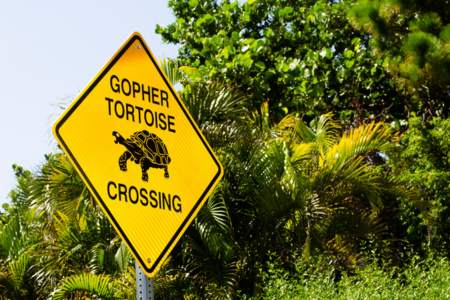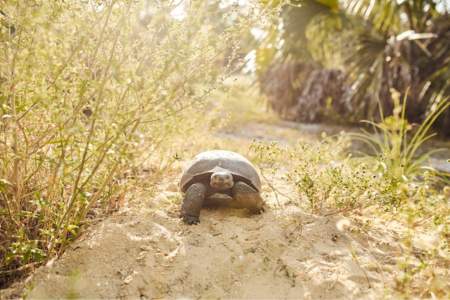The gopher tortoise (Gopherus polyphemus), a keystone species native to the southeastern United States, faces increasing challenges due to habitat loss and land development. In Florida, where these tortoises are particularly prevalent, the clash between urban expansion and wildlife conservation has brought gopher tortoise relocation into the spotlight.
Table of Contents
Understanding the Need for Gopher Tortoise Relocation
Relocating these tortoises is not just about moving an animal from point A to point B. It’s a delicate process steeped in ecological, legal, and ethical considerations. The gopher tortoise plays a pivotal role in its ecosystem, digging burrows that provide shelter for over 350 other species. Therefore, their relocation is not merely a matter of convenience but a critical conservation effort.
In Florida, the necessity for gopher tortoise relocation arises primarily due to land development. As the state continues to grow, more habitats are disturbed, necessitating interventions to safeguard these creatures. This situation presents a unique challenge: How do we balance the needs of a growing human population with the imperative to protect our native wildlife?
Can You Relocate a Gopher Tortoise?
Relocating a gopher tortoise is not a simple matter. In Florida, it’s a highly regulated activity governed by state laws to protect this threatened species. It’s illegal to disturb or relocate gopher tortoises or their burrows without a permit from the Florida Fish and Wildlife Conservation Commission (FWC). Permits must be applied for by a Registered or Authorized Agent. FWC offers various permits tailored to the specifics of each case. These include permits for smaller-scale relocations involving 10 or Fewer and larger-scale Conversation Permits.
The Importance of Permits
Permits play a crucial role in the process of gopher tortoise relocation. They are not mere bureaucratic hurdles but vital tools for ensuring that these sensitive relocations are done in an ecologically responsible manner. FWC issues these permits as part of a comprehensive strategy to protect gopher tortoise populations.
Each permit application requires detailed information about the relocation site, the number of tortoises involved, and the measures to be taken to minimize harm. This process ensures that the relocation is not only feasible but also beneficial for the tortoises. It includes habitat assessments, plans for capturing and transporting the tortoises, and monitoring their adaptation to the new environment. The permit system also serves as a check against unnecessary relocations.
How to Relocate a Gopher Tortoise
Relocating a gopher tortoise is a complex process that must be executed with precision and care. The steps involved require meticulous planning, a deep understanding of the tortoise’s ecological needs, and strict adherence to legal guidelines.
Steps and Best Practices in Gopher Tortoise Relocation
Relocating a gopher tortoise involves a series of carefully planned and executed steps. Each phase is critical to the success of the relocation and the well-being of the tortoises.
- Site Assessment: The first phase is conducting a survey of the property where gopher tortoises will be removed from. A 15% survey can be done initially, depending on the size of the land, but 100% of the land must be surveyed for gopher tortoise burrows. These burrows are categorized as either Abandoned or Potentially Occupied. Once it has been determined approximately how many burrows are present, the Agent performing the survey will work with the site owner to pick the most economical option. In some cases, tortoises can be relocated on-site for a much cheaper mitigation fee.
- Donor Site Assessment: If tortoises are being relocated to a different place, an ecological assessment of this site must be performed. This ensures that the gopher tortoises are not dumped into an environment they cannot survive in. This assessment involves examining soil composition, vegetation, and overall suitability to meet the specific needs of the gopher tortoise. The site must offer adequate food sources, suitable burrowing conditions, and a safe environment free from predators and human disturbances.
- Permit Application: Once all the data has been collected and the specific permit you are wanting to apply for has been determined, it is time to contact FWC. The number of tortoises being relocated will correlate directly to the amount of money needed to pay for the mitigation fee. Contributions can range from a flat $234 to $6,318 per tortoise (as of December 2023).
- Tortoise Capture: Once permits have been issued and a 24-hour notice has been provided to FWC, trapping can begin. Authorized and Registered Agents have a set of trained methods for removing tortoises from their burrows to relocate them to their new sites. These trapping methods are humane and standardized to ensure mortality is minimized as much as possible. Practices can vary from bucket trapping to manual excavation.
- Transportation: The transportation of the tortoises to their new home is another crucial step. It’s essential that the tortoises are transported in conditions that prioritize their comfort and safety, using specialized containers that prevent injury and reduce stress.
- Acclimatization: Upon arrival at the new site, it’s important to give the tortoises time to acclimatize to their new surroundings. This period allows them to familiarize themselves with the new environment, vital for their psychological and physical well-being.
- Monitoring: The final step is post-relocation monitoring. This phase is critical to ensure the tortoises adapt well and thrive in their new habitat. Monitoring includes tracking their health, behavior, and integration into the new ecosystem. This data is invaluable for assessing the success of the relocation and for informing future conservation efforts.
By following these best practices, we can ensure a responsible and effective relocation that prioritizes the well-being of these important keystone species, contributing significantly to the conservation of Florida’s diverse ecosystems.
Florida Gopher Tortoise Relocation Costs
Gopher tortoise relocation in Florida is a necessary but sometimes costly endeavor. Understanding the financial aspects is crucial for anyone considering or involved in land development where these tortoises reside.
Estimating the Costs of Gopher Tortoise Relocation
The costs of relocating gopher tortoises can vary widely based on several factors. These expenses typically cover permit fees, professional services for capturing and relocating the tortoises, site assessments, transportation, and post-relocation monitoring.
-
Scale of the Project: The number of tortoises or burrows involved significantly impacts the cost. Larger
projects with more tortoises require more resources and time, leading to higher costs. -
Permit Type: Different permits have varying costs. A permit for a small-scale relocation will generally
be less expensive than one for a larger-scale conservation project. -
Ecological Assessment: Thorough ecological assessments of both the original and new habitats can be
resource-intensive. -
Expert Involvement: The cost of hiring experienced wildlife biologists or ecologists, essential for
ensuring a successful relocation, can be substantial. -
Transportation and Acclimatization: Safely transporting tortoises to a new location and ensuring they
acclimatize involves specialized equipment and procedures, adding to the costs. -
Monitoring and Reporting: Post-relocation monitoring to assess the success of the move is a long-term
commitment that incurs additional expenses.
While the costs of gopher tortoise relocation in Florida can be considerable, they are an essential investment in preserving the state’s biodiversity. From obtaining permits to post-relocation monitoring, each aspect of the process plays a vital role in ensuring the successful relocation of these important keystone species.
Estimating the Costs of Gopher Tortoise Relocation – WITHOUT FWC Approval
According to Florida Administrative Code Chapter 68, “An illegal take of a gopher tortoise burrow includes, but is not limited to damaging, collapsing or covering a gopher tortoise burrow from land-clearing, bulldozing, grading, paving, or building construction associated with land development, without a permit issued under Chapter 68A, Florida Administrative Code.”
The specific fines and fees for violating gopher tortoise protection laws can vary widely depending on the jurisdiction and the nature of the offense. Civil fines for harming or disturbing gopher tortoises can range from a few hundred to several thousand dollars. The exact amount may be determined by factors such as the number of tortoises affected, the extent of the damage, and whether the violation was intentional. Offenders may be required to cover the costs of restoring or mitigating the damage caused to gopher tortoise habitats. This could involve expenses related to habitat restoration projects, research initiatives, or contributions to conservation funds.
In more severe cases where intentional harm or repeated offenses occur, criminal charges may be filed. Criminal penalties can include higher fines and the possibility of imprisonment. Imprisonment terms, if applicable, may range from several months to a year or more, depending on the severity of the violation.
Gopher Tortoise Relocation Services in Florida
Gopher tortoise relocation in Florida is a specialized task requiring FWC-trained agents. This training includes in-depth knowledge of the Florida Administration Code Chapter 68A-27, gopher tortoise biology and ecology, established survey methods, proper handling practices, and a multitude of other best practices. While anyone can survey their land and apply for a permit, FWC will not grant the permit to anyone without rigorous training and experience.
How To Choose the Right Service
When selecting a gopher tortoise relocation service, several factors should be considered:
- Expertise and Credentials: Services should include an FWC Authorized Agent with all the necessary credentials for trapping, tagging, and relocating gopher tortoises. At AOTC, we have an established team of qualified and experienced wildlife experts who can help you relocate this important native species without breaking the bank.
- Proven Track Record: Look for providers with a history of successful wildlife management and relocation projects. AOTC’s established record in environmental services offers reassurance of our capabilities in handling complex relocation tasks.
- Care for the Environment: Feel assured that you do your part in keeping Florida natural and pristine by working with small local businesses that have a stake in their environment. AOTC was established in Florida and cares about keeping native species safe and healthy.
Legal compliance is paramount in gopher tortoise relocation. We at AOTC adhere strictly to Florida Fish and Wildlife conservation laws. We stay up-to-date and informed on any changes in the laws and regulations. This way, we ensure the continued survival of this important species, as well as the plethora of other native species their burrows are home to.
Work With AOTC For Relocation
The relocation of gopher tortoises in Florida is more than a regulatory compliance or a conservation effort; it’s a commitment to preserving a vital part of our natural heritage. As we’ve seen, this process requires careful consideration, from understanding the intricate ecological roles of these tortoises to adhering to strict legal guidelines and ethical practices.
If you’re facing the need for gopher tortoise relocation, or if you’re involved in land development in Florida and want to ensure your actions align with the best conservation practices, reaching out to AOTC is a step in the right direction. Not only will you be complying with state laws, but you’ll also be contributing to the preservation of Florida’s unique ecosystems and the species that inhabit them.
Contact AOTC today to learn more about our gopher tortoise relocation services and how we can help you achieve your environmental and conservation goals responsibly and effectively.


